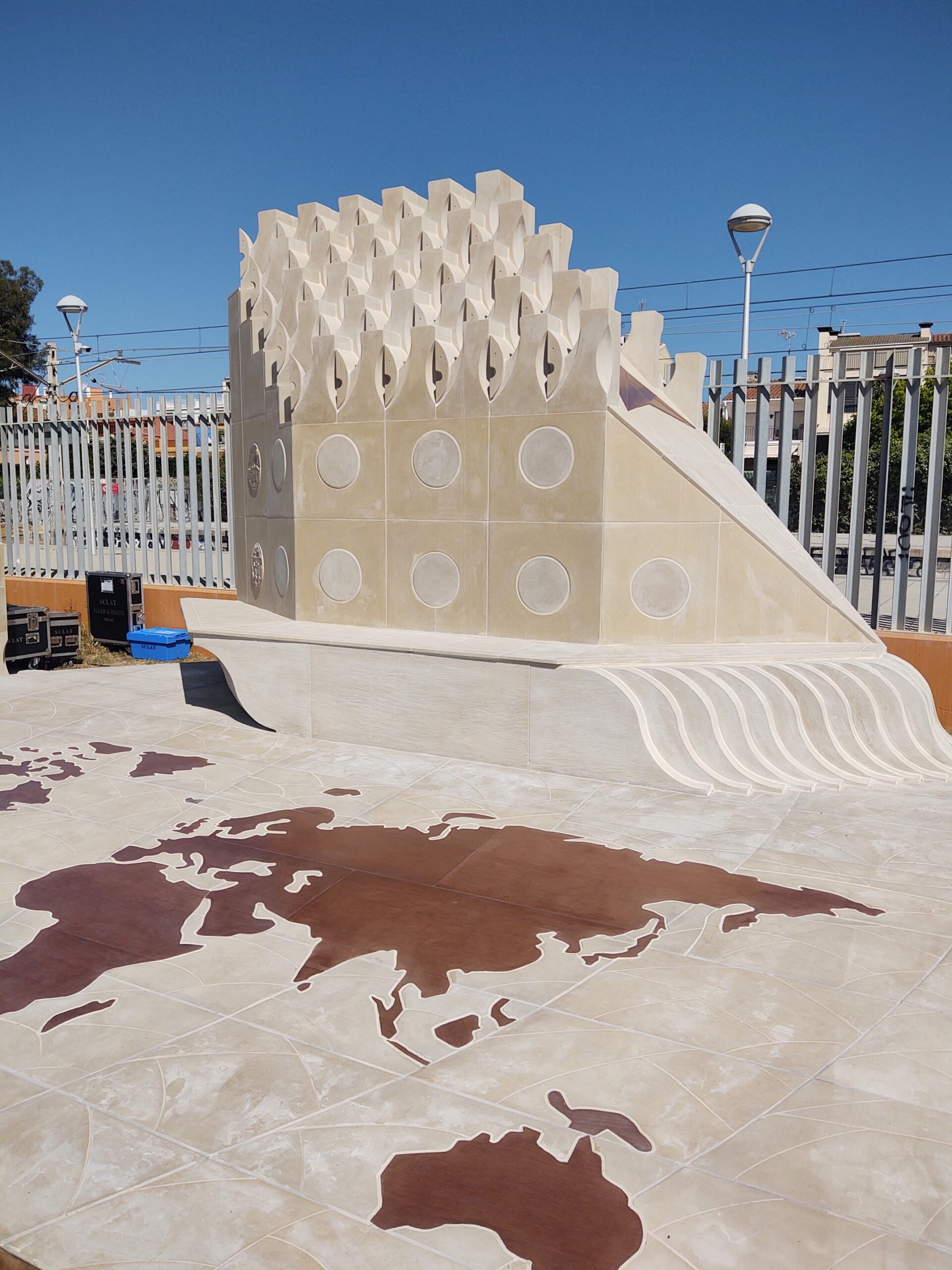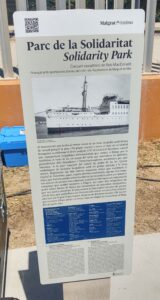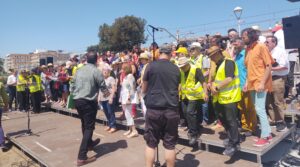New Monument in Catalonia Commemorates IB Victims on Torpedoed Ship
 Sixty people died when the Ciudad de Barcelona was torpedoed by the Italians off the Catalan coast. Rob MacDonald’s interactive Solidarity Park turns their memory into an invitation for activism.
Sixty people died when the Ciudad de Barcelona was torpedoed by the Italians off the Catalan coast. Rob MacDonald’s interactive Solidarity Park turns their memory into an invitation for activism.
On May 30, 1937, a Sunday, the Ciudad de Barcelona, a ship transporting volunteers for the International Brigades (IB) from Marseilles to Barcelona, is sunk by a torpedo from an Italian submarine supporting the Francoist insurrection off the coast. At least 60 people die. The survivors are rescued by the people of Malgrat de Mar, a coastal town in Catalonia. The ship sinks to the bottom of the sea. After the war, under the Franco regime, it will be stripped of its iron.
Eighty-five years later, on the weekend of Memorial Day in the USA, the people of Malgrat witnessed the unveiling of Solidarity Park, a monument that commemorates this historical event. Created by the English sculptor Rob MacDonald, who lives in Spain, and made possible thanks to community participation and municipal support, the park seeks to remember the brigaders who came to Spain to support the Republic—and indeed the history of the Civil War itself.
The memorial, which sits on the edge of the ocean in Malgrat, is topped by representations of 60 faces with raised fists, representing the 60 IBers who died on the Ciudad de Barcelona (CdB), rising over an inlaid map of the world representing the countries IB volunteers came from. MacDonald’s monument is meant to be dynamic, not only to be seen but to be interacted with and to be walked on—and even defaced by political opponents or simple graffitists. Any future restoration is built into the monument’s lifecycle. The monument’s circular “portholes,” meanwhile, will eventually contain depictions of aspects of the event from drawings by high school students from Catalonia and other countries. Two have already been placed, and four more will be added next year, selected by vote from more than 250 submissions. This process will continue for years to come. (The review the submissions and to vote, visit solidaritypark.com. Teachers who want to be part of the project next year can email info@solidaritypark.com.)
Most important to MacDonald and his collaborators, however, is the educational program that accompanies the monument (see inset). History teacher Sònia Garrangou, a native of Malgrat, has supplied much of the historical information about the CdB and the war. For several years, students have studied the events related to the sinking of the ship but also the greater issues in the struggle. They have created art that may adorn the “portholes” in the future, as well as essays and videos about various IBers who traveled on the ship. Some of these students presented at the three-day event associated with the memorial’s unveiling. They included two Ukrainian students now studying in Malgrat, who brought poignant currency to the celebration.
The attendees included family members of IBers who died on the CdeB, those who survived only to die later in the war, and those who survived the Civil War, often again fighting in WWII. The families—from the UK, the US, Australia, and France—had the opportunity to speak with the students, finding out what they have learned and what it means to them. The audience included many locals and representatives from other parts of Spain and other countries, many of whom sang in choirs from Catalonia, Wales, England, Croatia, France, and Sweden. Saturday afternoon featured inspiring choir performances, while at the Sunday dedication of the memorial they all sang the Internationale together, in seven languages, commemorating those who died on the CdB—and who, as the survivors later testified, sang it as the ship went down.
The dedication included speeches by principles in the project, including MacDonald, Garrangou, Mireia Serrano, Assumpta Merdaguer, the mayor and alderman of culture of Malgrat, as well as representatives of Catalan organizations that preserve the history and memory of the Civil War and the International Brigades. (For the entire program, see the online edition at albavolunteer.org.)
History never ends. The story of the Ciudad de Barcelona allows us to get closer to the past, to our past, to everyone’s past. It is an arrival point and also an end point. The selfless participation of people and groups from all over the world makes us think that there is indeed hope.
Jack Freeman (1918-1938) survived the sinking of the CdeB but was later killed at the battle of the Ebro, in September 1938, at the age of 20. The authors of this piece are his family members, Joshua Freeman (nephew), Rebecca Freeman (niece), Amy Freeman (niece), Sonja Prins (grandniece), Pat Kelly and Bill Bemis (spouses).
 The Artist
The Artist
Rob MacDonald, President of the Associació Solidarity Park in Malgrat de Mar, is a multidisciplinary art activist specializing in community participation monuments and creative language teaching.
How did you go about getting the community involved?
Rob MacDonald: While crowdfunding for the monument, we were able to build support among the local government, the local community, and the international community. Community participation and art have been central to the project from the outset because we believe that ownership of the process helps create a lasting historical memory in new generations. Alongside the many broader community activities, we developed the school initiative which has now been running for 5 years and is now expanding.
What’s the goal in this initiative?
The aim is simple: to create critical thinkers in the next generation of young Catalans and international students—thinkers who become not only aware of the role of the International Brigades and their values, but understand it in the context of their families, communities and country. We want them to be independently able to assess the historical data available and make informed interpretations of history. We think this is central to building a barrier to the growth of far-right ideologies which can plague the political terrain in times of economic and social crises, and which have been a continued feature of the capitalist system we live within.
What does that look like?
We have created a guide in Catalan and English, developed by Sònia Garangou, that helps teachers develop student activities. The program, which is directed at 14- to 18-year-olds, can be adapted to any school’s needs. After a basic introduction to the Spanish civil war, the program starts with an escape room activity that introduces the subject to the students in a fun way. Then we move on to a project focusing on a story of a brigadista, in which students often produce a podcast or video presentation. As the artist, I make myself available to visit classes, in person or online, to give an explanation of the project. I ask the students to “tell this story to the world” by creating drawings in the form of portholes. From these drawings each year a number are voted on by the public to be made in stone and go on the Solidarity Park monument. This year there were 248 designs submitted, of which 12 were voted finalists and 4 will be chosen to go on the monument in 2023. In this way, the monument is continually being updated. It becomes a living artwork for the community to interact with. Within all this, there is plenty of room for variation. For instance, German students made their portholes into graffiti: they graffitied the designs, with removable paint, to commemorate a brigadista that came from their town. The program closes with a gathering at the annual Solidarity festival, where the students share their art and learning with the community.
So you also work with students beyond the Malgrat area?
In fact, the internationalism of the school project is key. We have also had students from Germany, Sweden and Australia. To be sure, the project is based in Catalonia and especially in the areas near the sinking of the Ciudad de Barcelona. But since the ship carried brigadiers from around the world, it’s possible for international students to connect as well. In 2017 we started in two schools, 2019 there were five schools and this year in 2021/22 there were eight participating schools: four in the area of Malgrat de Mar and Lloret de mar, three in Barcelona, and one in Germany. This July we have spoken directly to 25 different history teachers and hope to spread across Catalonia. We are part of a number of important school initiatives across the Spanish state that are trail-blazing change in the forgotten (or suppressed) questions surrounding the historical memory of the war and the dictatorship. We hope very much in the future school students will participate from other countries, especially from the United States and Canada as so many of the brigadiers that were known on the Ciudad de Barcelona are from these countries.
What can interested teachers do?
Contact us! We are now an international association which you can join. We are transparent and democratic and hold regular multilingual meetings of international supporters mixed with local people. You can access our education dossier and the project and from our website, solidaritypark.com, and view much of the work on our YouTube channel. For up-to-date info, follow us on Facebook, Twitter and Instagram.
















Hello Volunteers: Catalonia is proud to remember the international brigade members who fougth for democracy in Spain.
I honor all of them for their dignity.
I also honor the memory of my fathe who was a fighter in Catalonia for the Republic during de Spanish war.
I carry all of you in my heart.
I hope you return to Catalonia and we can meet .
MARIA (Barcelona)